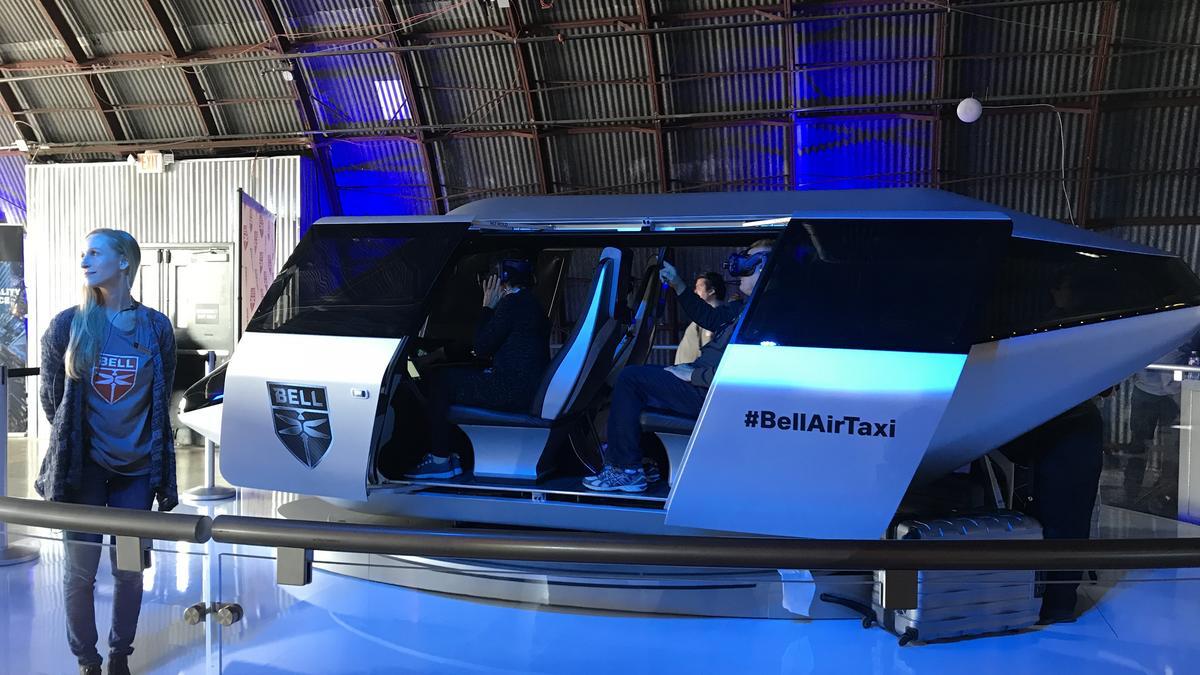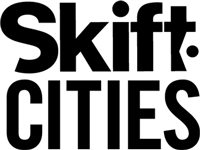Skift Take
It makes sense that the City of Fort Worth and Visit Fort Worth leveraged SXSW's cool factor and global tech audience to help reposition the destination brand around innovation and creativity. The question now is how to keep that momentum going moving forward.
This post is original content created by the SkiftX brand strategy team for our Skift Cities platform. Learn more about what SkiftX can do for partners here.
This sponsored content was created in collaboration with a Skift partner.
The Bell Urban Air Taxi could potentially be the first “flying car” to enter mainstream production in the next decade. Based in Fort Worth, Texas, the Bell company was an early innovator in helicopter technology, and now it’s attempting to repeat that first-to-market status in autonomous air mobility.
Last month at South by Southwest (SXSW) in Austin, attendees had a chance to sample what living in Blade Runner will eventually feel like by stepping inside one of Bell’s eVTOL (electric vertical takeoff and landing) simulators.
The Bell experience was part of the Fort Worth Now activation at SXSW that showcased innovative Fort Worth-based companies and creative entrepreneurs. The event and programming were co-produced by Visit Fort Worth and the Fort Worth Chamber of Commerce to help reshape the city’s image on a global stage.
The overall investment was about $500,000, paid for by the private sector and the City of Fort Worth’s Promotion and Development Fund.
Every year at SXSW, a growing number of cities and countries are creating branded, pop-up “SXSW Houses” to promote their advanced industries and cultural influencers. Governments and economic development organizations worldwide are attempting to position their destinations as diverse, progressive, and interdisciplinary incubators for new ideas, in an attempt to attract outside corporate investment and talent.
Aligned with that, convention and visitor bureaus like Visit Fort Worth are promoting their local spirit of creativity, innovation, and maker culture more aggressively today to attract the next generation of leisure and business travelers.
SXSW is where all of those themes come together.
The primary strategy behind the launch of Fort Worth Now focused on tackling a couple long-standing challenges facing the city.
One, Fort Worth is often viewed somewhat in the shadow of Dallas. Two, the Fort Worth brand is too connected to the region’s Western heritage, considering the evolution of the city’s knowledge base.
Therefore, tourism and civic leaders are on a shared mission to expand Fort Worth’s reputation beyond its cowboy culture, by emphasizing the local technology expertise and unique creative energy, to compete with other midsize cities across the nation.
Last December, the Fort Worth Economic Development Strategic Plan included a survey showing how people perceive the size of U.S. cities. While Fort Worth is the nation’s 16th most populous metropolitan region, survey respondents ranked Fort Worth as the 45th largest city when asked to compare it against other destinations.
Fort Worth has a population of more than 850,000, and it’s among the fastest growing cities in the country. Dallas is about 1.3 million. And yet, the research suggests that people think of Fort Worth as a suburb of Dallas.
“Following the release of the strategic plan, we realized we had a lot of work to do so that perception could catch up with reality,” says Mitch Whitten, VP of marketing at Visit Fort Worth. “That coincided with us having talked about doing something in a big way with the Fort Worth Chamber of Commerce to produce a coming out party at South by Southwest.”
The end goal for the SXSW activation was really about making the Fort Worth brand more cool, more international, and more diverse. Especially more cool.
“The urban air taxi is a few years off, and DFW Airport is a test market for that, but there’s a cool factor there because those types of technologies are being built in Fort Worth,” Whitten says. “Now, the cool factor relating to that specific technology might not be a visitor experience today, but it adds luster to the overall visibility of Fort Worth and the brand.”
Cross-Sector Convergence
Fort Worth Now was housed in and around the 16,000-square-foot Fair Market warehouse venue in downtown Austin.
Inside, there were a group of branded experiences showing the spectrum of Fort Worth’s technological prowess and cultural vibe. Aside from the Bell experience, Lockheed Martin brought its F-35 jet fighter training simulator for people to explore how the world’s most advanced plane connects man and machine.
At the same time, Fort Worth photographer Rambo Elliott and Fort Worth Barber Shop owner Jonathan Morris were on hand to take photos, give free haircuts and beard trims, and share their stories about the city’s lifestyle scene.
There was also a stage for numerous panels discussing business and tourism trends, ranging from How Apps Are Shaping the Future of Travel to Creating a Venture Capital Ecosystem.
“The travel app session was the most successful panel, and we took a different approach than focusing just on the technology,” explains Whitten. “The three travel editors really gave a people-driven perspective about the apps they themselves use without being consumed by technology.”
Outside, there was another stage for presentations delivered by people such as Fort Worth Mayor Betsy Price, and music performances from local Forth Worth bands like Bonnie Bishop and The Texas Gentlemen.
Also outdoors, the Fort Worth Makers Market provided a glimpse into the city’s independent DIY entrepreneurial ecosystem.
“The mix of makers and ambassadors representing different sectors at Fort Worth Now, where you had Texas whisky distillers next to Bell engineers, created an exciting intersection of commerce and tourism,” says Whitten. “We’re mostly known for our Western heritage and friendly hospitality. What’s important to us now is to build on that, and explain there’s a lot going on here as well, whether that’s the growth of our music and film scene, our food and craft scene, or our tech industry.”
At the end of the day, Fort Worth Now was about Fort Worth’s economic growth and workforce development heading into the future. But to entice companies to invest in a city, you first have to get them to visit. That’s the bridge connecting Visit Fort Worth and the Fort Worth Chamber of Commerce.
That’s also the value for the increasing number of destination coalitions launching branded SXSW Houses. The convergence of interdisciplinary programming in Austin every spring has made SXSW one of the nation’s top conferences for helping economic development and destination marketing organizations align their shared goals.
Ultimately, it’s a vehicle for linking a destination’s innovation and visitor economies to build better cities.
“We created a business lounge where our mayor and some corporate representatives could host some of the folks coming by,” says Whitten. “We were very intentional about creating a space where domestic and international corporate leaders could meet with our city leadership.”
Also, in Fort Worth’s case, the international crowd at SXSW provides the right kind of audience to help grow the city’s reach. Presently, only 5 percent of inbound visitors are international, according to Whitten, but they represent 15 percent of visitor spending.
Logistics aren’t the problem. Fort Worth is home to one of the most connected airports in the world. The challenge is getting international people to understand, and really feel and embrace, what Fort Worth stands for that’s different from Dallas.

The above content was produced by the branded content SkiftX team for the upcoming Skift Cities platform, defining how cities are connecting visitors and locals to co-create the future of urban UX.
Have a confidential tip for Skift? Get in touch
Tags: fort worth, skift cities, sxsw
Photo credit: The Bell Urban Air Taxi simulator. Bell


